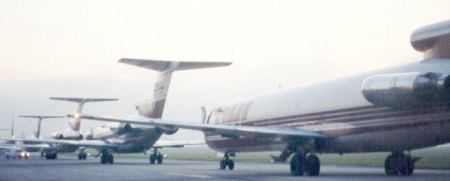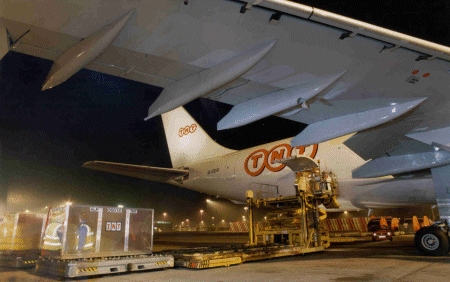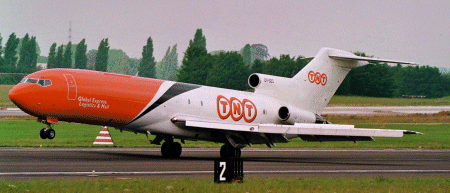Max Kingsley-Jones/BRUSSELS AND LIÈGE
Every night of the working week, up to 100 aircraft distribute more than 2,000t of packages across Europe. This impressive figure is expected to see the double digit growth witnessed during the 1990s continue into the coming years.
Although the World's "big two" express package carriers - FedEx and United Parcel Service (UPS) - have a presence in Europe, the bulk of the movements each night are generated by smaller firms: DHL and TNT. Both companies are undergoing major change to cope with market demands and environmental issues, as they look forward to even greater demand for package delivery as the e-commerce revolution bites.
DHL was formed in 1969 by three Americans - Adrian Dalsey, Larry Hillblom and Robert Lynn - and initially served the US west coast and Hawaii. Thirty-one years on, the DHL group boasts annual sales in excess of $5 billion, employs over 61,000 people and operates 33 hubs throughout the world. The company's major shareholders are Lufthansa and Germany's Deutsche Post.
The first aircraft, a small Beechcraft, was leased in 1975, and as business expanded DHL set up its main US air hub in Cincinnati, Ohio, in April 1983. Two years later a "DHL International" hub was established in Europe at Brussels Zaventem airport. DHL now has 220 aircraft flying for it throughout the world.
DHL figures show that the express parcel business worldwide grew eight-fold from $500 million to $4.5 billion during the 1980s, and European air cargo growth has been phenomenal: "When I arrived in Brussels in 1988, we had a few [Fairchild] Metros, Beech 99s and Convair 580 turboprops and we were handling around 60t per night," says Godon Olafson, DHL's director of air transport Europe. "A little over 1,000t now goes through Brussels each night, and we have established five outer hubs throughout Europe".
With 70% of Brussels' nightly throughput going by air (the rest goes by truck), the hub is easily Europe's largest air cargo centre. Each night 28-30 aircraft fly into and out of the Brussels hub between 2330h and 0400. Meanwhile US-based DHL Airways operates 40 aircraft on the North American network from the main hub in Cincinnati, which processes around 900t of cargo each night.
Growth rate
DHL International's European and African air network is the responsibility of wholly owned Brussels-based arm European Air Transport (EAT). DHL's European network experienced average annual growth rates of around 20% throughout the 1990s. A 19% increase was achieved in 1999 with around 14-15% growth a year expected going forward.
EAT's owned and leased fleet consists of 57 freighters: nine Convair 580s, 28 Boeing 727s (22t volumetric payload), three Boeing 757-200PFs (28t volumetric payload) and 17 Airbus A300B4 freighters (35t volumetric payload) with two more due to join the fleet. Smaller freighters, as well as two Lockheed L-188 Electras from Atlantic Airlines and two Boeing 737-200/300Fs, are subchartered or wet leased.
Last year, EAT completed a complex $1.3 billion deal involving Boeing and British Airways which will mean the carrier will replace its 727s from early next year with the first of at least 34 ex-BA 757-200s after conversion by the manufacturer to special freighters (SFs). A further 10 757-200SFs are also planned which will give it a fleet of 44 (of 25t volumetric payload) twinjets by mid-decade.

The need to find a quick and effective replacement for the venerable 727 resulted from growing environmental pressure in Europe, particularly in Belgium. Proposed night-time noise legislation - due to come into force within 2-3 years - will banish the 727 from Belgian skies. In the longer-term, EAT sees a requirement for a new 6-8t payload freighter such as the ATR 72 and British Aerospace ATP to replace the nine ageing, but extremely functional, Convair 580s, five of which are operated by Swiftair of Spain.
The introduction of the A300B4F in 1998 was a bold expansion move - the aircraft are effectively twice the size of the 727s which they have replaced on many routes. Adding the widebodies required a lot of planning to ensure that the aircraft could be loaded and unloaded efficiently within the timeframes established for smaller types.
EAT's policy is to operate some aircraft under its own air operator's certificate (AOC) and place others with carriers who fly them on DHL's behalf. Olafson says that for the 757 fleet, some of the aircraft will be flown by EAT and others with another DHL AOC holder, probably based in the UK.
Although EAT is pleased with the growth that the A300 has provided and with the 17-23 year-old twinjets' operational reliability, the airline is disappointed that the operating economics have failed to match expectations.
DHL's A300 fleet achieves around 120h a month utilisation and its flight/cycle ratio is about 1:1. The widebody - in much demand with freight airlines in recent years - has a high cost per flight cycle, says EAT, which particularly hurts cargo operators due to the short flight/low utilisation nature of the business. Much of this cost penalty results from the maintenance requirements per cycle of the A300's General Electric CF6-50C2 engines.
The A300 will form the backbone of DHL's European widebody fleet in the immediate future, but EAT hopes to have a long- term plan in place within five years. With the large fleet of 757s heading in DHL's direction, the airline sees the 767SF as the leading candidate to meet its long term requirements as it would provide flightdeck commonality with the 757.
Although much of DHL's traffic travels across Europe via Brussels, the establishment of outer hubs five years ago means that a number of flights operate point-to-point and bypass Brussels. The five outer hubs - East Midlands (the largest), Copenhagen, Cologne, Bergamo (Italy) and Vitoria (Spain) - handle 650-700t a night between them, says Olafson.
Two McDonnell Douglas DC-10-30Fs wet-leased from Gemini operate each night across the Atlantic, connecting DHL's European and US networks. EAT also flies between Bahrain and Brussels six times a week to connect into the Middle Eastern network, while the African network is served through flights to Lagos, Nigeria.
Capacity constraints
Olafson says it is not yet clear what the impact of the new noise legislation will be in Brussels as it has not yet been officially finalised, but it will effectively be a noise quota system. He adds that the other constraining factor on growth is the amount of capacity left in its Brussels hub.
"There is about 15-20%" more growth in the existing facility," says Olafson. "The effective limit is aircraft parking availability." Some of the required growth will be swallowed by the outer hubs, he says, but the main hub will reach its maximum within the next couple of years.
"We will push more traffic onto direct routings from the outer hubs and bypass the Belgian capital. By 2002 we will probably be handling as much through the outer hubs as we do through Brussels," says Olafson. "Any decision on whether to build a new facility at Brussels is at least 12 months away, and it will take 2-3 years to get up and running. Future expansion will depend on how the new environmental regulations pan out. We have no intention of leaving Brussels-we have made such a huge investment here," he adds.
About the time DHL was establishing itself in Europe, road trucking specialist TNT created an air hub to support its European operations. After initially operating from a hub in Nuremburg from May 1987, TNT set up shop alongside UPS at Cologne in 1988 with a small fleet of BAe 146 Quiet Trader (QT) freighters.

Like DHL, TNT has come a long way in the 13 years since. It boasts a fleet of 26 aircraft, ships 460t by air each night and moved into its own purpose-built European "super-hub" in Liège, Belgium, in March 1998. Its recently created in-house maintenance and AOC operation, TNT Airways, is also based here.
TNT's network is the reverse of DHL's, with its air network representing just 35% in value terms of all shipments - the remainder is carried by the massive trucking division which has its European road hub in Arnhem, Holland. The TNT group was purchased at the end of 1996 by Dutch postal service KPN, which is now the TNT Post Group (TPG).
The publicly listed organisation employs 116,000 people worldwide and operates in more than 200 countries, with revenues in excess of €8.5 billion ($9.8 billion). The airline arm employs around 540 people.
Formed in Australia in 1946 as Thomas Nationwide Transport, TNT first established itself in the UK in 1978. TNT decided to create its its own dedicated air operation, and in early 1987 acquired the first of seventeen 11/12t payload 146QTs and signed up Luton, UK-based Air Foyle to provide the required air-operator's certificate and crews.
European expansion
In 1992, TNT took over FedEx's European distribution when the US carrier withdrew its own dedicated operations from the region. The US giant has since reversed that decision and is developing a major hub at Paris Charles de Gaulle airport.
TNT's expansion in Europe saw it establish a central hub in Cologne during 1988, and create other operating bases.
After a slow start, TNT's air network in Europe was experiencing annual compound increases of 25-30% by the mid-1990s. In recent years, business has been growing at an average 8-12% annually in weight terms and 12-15% in volume. Last year volume increased by 18%.
"In 1992 we realised that we needed to examine how we catered for our long-term growth," says TNT managing director Niky Terzakis. "We short listed two sites - our existing hub in Cologne and the former military air base at Liège," he adds.
The strong environmental lobby at Cologne, plus the lack of any real opportunities to expand, dissuaded TNT from developing its hub. Liège airport meanwhile was trying to attract cargo operators and offered TNT a "green field" site to build a dedicated hub facility and plenty of expansion prospects.
advanced cargo hub
The deal was signed with the local Walloon government in February 1996 to acquire land at the airport on long-term lease. A total of €57 million has already been invested in the project to create the most advanced air-cargo hub in Europe, including a 26,000m2 sort centre. The hub is designed to be developed over a three phase/15 year modular expansion plan that will allow throughput to grow 400% from the current 50,000 packages an hour to 200,000.
Another attraction was the prospect of a high speed rail link, says Terzakis. "We expect to have the train at the airport in three to five years and we will definitely use it. Dedicated freight trains capable of handling ULDs [industry standard cargo pallets] can be loaded with 25-30t of cargo in 10 minutes," he adds.
The train will provide a much more cost effective way of moving packages to key cities such as Paris, Brussels, Frankfurt and Cologne. Liège also functions as a mini-road hub, with around 80 trucks passing through each night. "Thirty percent of the cargo going through the hub comes by truck - it is 10 times more expensive to carry goods by air than by road," explains Terzakis.
As part of the relocation, operations were restructured under a single TNT-held AOC, based in Liège. At one time the 146QT fleet was distributed with seven operators throughout Europe - Air Foyle (UK); Eurowings (Germany); Malmo Aviation (Scandinavia); TNT Malév (Hungary); Euralair (France), and TNT-owned Pan Air (Spain) and Mistral Air (Italy). "Seven operators equal seven overheads," says Terzakis.
Transferring operations
Operations began under the TNT AOC in mid-February, with aircraft and crews being progressively transferred from the non-TNT operators. "The crews are working slightly harder now and we have standardised employee conditions and reduced costs," says Terzakis.

Like the 146s, TNT's expanding fleet of A300B4Fs are operated under the AOC, but the seven 727-200Fs continue to be flown by Sterling Airways as they will soon be phased out. Two A300s are in service with TNT, while a third is operated by Schreiner Airways but is due to join TNT's Spanish arm Pan Air next month. Several aircraft are operated for TNT on wet-lease including a single Tupolev Tu-204C.
TNT has firm commitments for three more A300B4Fs and until recently had envisaged ultimately operating 14 of the type. The company has, however, decided to phase out its 727s more rapidly (all but two will leave the fleet next year) and is examining a medium-sized, 25-30t payload freighter to replace the trijets and fill the gap between the 146s and A300s.

"Depending on the aircraft we chose and the number we acquire, our A300 fleet will probably number only eight or 10 aircraft," says Terzakis, who declines to specify the types under examination but which are understood to include the Boeing 757, 737-300 and Tu-204C. A decision is due by the end of the year, to allow the new aircraft to replace the 727swithin two years.
Source: Flight International
















